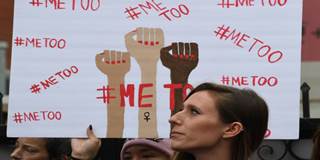Globally, almost half of women journalists report having experienced work-related sexual harassment, and two-thirds have faced “intimidation, threats, or abuse,” mainly from bosses, supervisors, or co-workers. How can newsroom managers change the organizational culture that has allowed such behavior to thrive?
LONDON – Journalism classrooms may be dominated by women, but global media are still ruled by men, who occupy the majority of management positions, report more news stories and are more frequently presented as expert voices. This imbalance is reflected in the content newsrooms produce, with fewer written words and broadcast seconds dedicated to telling women’s stories. It is also reflected in the industry’s culture, which leaves women more vulnerable to sexual harassment and abuse.
Given the importance of relationship-building in media, not to mention the desire for connection among journalists who cover extreme or harrowing events in difficult environments, intimate ties can easily form among colleagues and associates. The problem arises when these relationships turn sour or, worse, when they are non-consensual or based on coercion, such as when a more senior colleague pursues a sexual relationship with a subordinate.
Of course, across countries, there can be significant differences in what is considered predatory or inappropriate behavior. But, globally, almost half of women journalists report having experienced work-related sexual harassment, according to a 2014 study by the International News Safety Institute (INSI) and the International Women’s Media Foundation (IWMF). Two-thirds reported that they had faced “intimidation, threats, or abuse,” mostly by bosses, supervisors, or co-workers.

LONDON – Journalism classrooms may be dominated by women, but global media are still ruled by men, who occupy the majority of management positions, report more news stories and are more frequently presented as expert voices. This imbalance is reflected in the content newsrooms produce, with fewer written words and broadcast seconds dedicated to telling women’s stories. It is also reflected in the industry’s culture, which leaves women more vulnerable to sexual harassment and abuse.
Given the importance of relationship-building in media, not to mention the desire for connection among journalists who cover extreme or harrowing events in difficult environments, intimate ties can easily form among colleagues and associates. The problem arises when these relationships turn sour or, worse, when they are non-consensual or based on coercion, such as when a more senior colleague pursues a sexual relationship with a subordinate.
Of course, across countries, there can be significant differences in what is considered predatory or inappropriate behavior. But, globally, almost half of women journalists report having experienced work-related sexual harassment, according to a 2014 study by the International News Safety Institute (INSI) and the International Women’s Media Foundation (IWMF). Two-thirds reported that they had faced “intimidation, threats, or abuse,” mostly by bosses, supervisors, or co-workers.